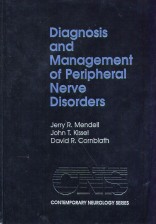|
|
|
| |
 |
|
|

|
 推薦指數:
推薦指數:





|
|
- 內容介紹
|
Diagnosis and Management of Peripheral Nerve Disorders (Contemporary Neurology Series, 59)
by Jerry R., Md Mendell, John T., Md Kissel, David R., MD Cornblath
Hardcover 1st edition (March 15, 2001)
Oxford University Press; ISBN: 0195133013
From the New England Journal of Medicine, October 4, 2001
Diagnosis and Management of Peripheral Nerve Disorders is the latest in the valuable Contemporary Neurology Series from Oxford University Press. Although multiple experts contributed to the book, the three editors helped to write all but 5 of its 31 chapters. Their stated purpose is ``to create a book that could be easily read from cover to cover [and] that touched on all the important aspects of individual neuropathies.'' In general, they have succeeded.
Part 1, which comprises the first eight chapters, describes the general approach to the patient with neuropathy, emphasizing the importance of history taking and physical examination, providing a general classification, and citing useful laboratory techniques. The limited applicability of nerve biopsy is appropriately emphasized. Chapter 3, which focuses on electrodiagnostic testing, is surprisingly brief, perhaps to avoid overlap with later chapters. Despite its brevity, a detailed case report is inserted. Here, and in many subsequent chapters, the space could have been better used for other purposes. Chapter 4 describes quantitative sensory and autonomic testing. Although the authors state that such testing provides ``an objective measure supporting a neuropathy,'' it is more apt to be useful in clinical trials than in clinical practice. Chapter 6, which describes testing for autoantibodies, is particularly helpful for its critique of the wasteful practice of ordering a battery of expensive antibody titers without appropriate rationale. Chapter 7 clearly delineates the value of nerve biopsy. The histologic images here, as elsewhere in the book, are well reproduced (whereas the few magnetic resonance images scattered throughout are less well rendered). The last chapter in this section, on painful peripheral neuropathies, is quite useful and made me wonder whether chapters on other general aspects of peripheral neuropathy (e.g., the management of trophic ulcers and the role of rehabilitation) should also have been included.
Part 2, which comprises the remaining three quarters of the book, deals with specific categories of neuropathy. The quality of individual chapters in most cases is very good. Particularly strong are the chapters on acute and chronic idiopathic polyneuropathies, peripheral neuropathies associated with connective-tissue diseases, neuropathies associated with monoclonal gammopathies, toxic neuropathies, diabetic neuropathies, neuropathies associated with human immunodeficiency virus infection, leprous neuropathy, and entrapment neuropathy.
|
|
|

